Dream On is an exploration of dreams, the unconscious and an imaginary world between sleep and wakefulness. The exhibition plays with the notion that objects come to life when we are not looking, much like our dreams when we fall asleep. The different elements tell an interwoven story of how the inanimate can become animated, and reveals the uncanny visual power of our dreams.
It is currently displayed in the Museum of Childhood’s gallery that showcases artists’ responses to the collections, and work produced in co-created projects. We work with local primary and secondary schools, FE colleges, universities and community organisations. Each exhibition brings together the work of established and emerging artists – and the young designers of tomorrow.
The projects introduce countless newcomers to the museum, offering them an intense creative opportunity and a chance to look at the collections in new, playful ways. When taking part in an artist-facilitated process, participants become stakeholders in a shared platform that gives them a highly visible presence and a voice. The exhibitions also create an ongoing connection as participants return to see their own achievements on display.
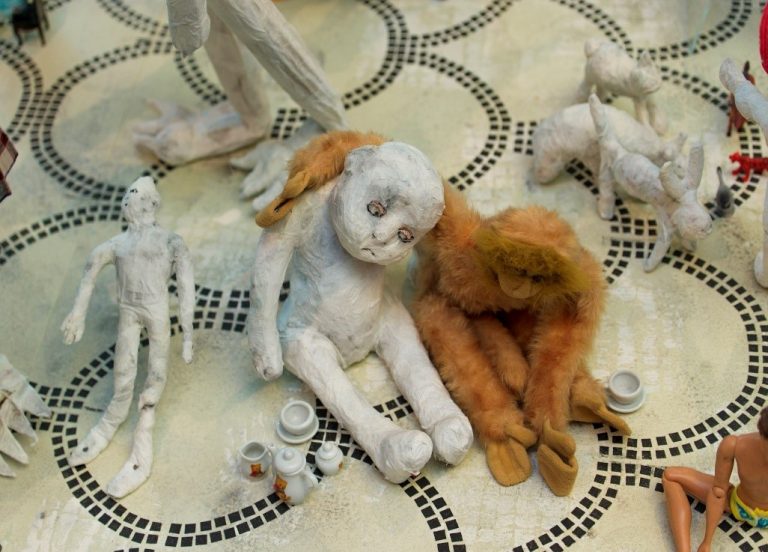
‘Ludus Est’ by Christie Brown
The exhibition is built around a body of work by artist Christie Brown, made in response to the museum’s collections. I first saw a figurative installation ‘Sleepover’ by Christie Brown (Emerita Professor of Ceramics at the University of Westminster) at the British Ceramics Biennial in 2013. The theatrical piece had a real resonance with some of the museum’s collections, and I could see the potential for developing a Front Room project. Pieces displayed in the gallery has to work for a wide range of audiences, but also needs to capture the imagination of the young people who are working on their own creative responses.
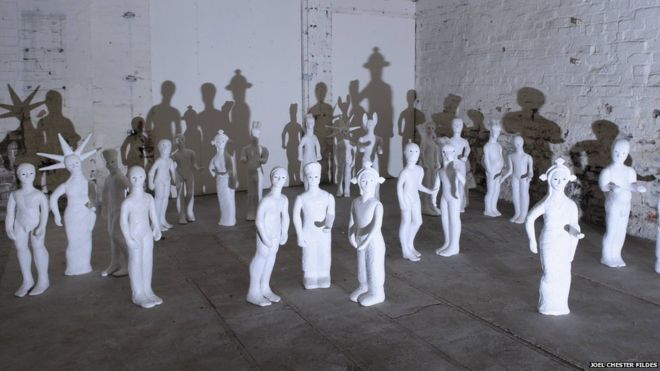
‘Can We Photograph Our Dreams’ by Lauriston Primary School
Within the exhibition there was also a thematic link to a photography project in a local primary school that explored dreams. Artist Katherine Tulloh and photographer Madeleine Waller worked with 60 year 5 pupils from Lauriston Primary School, Hackney, over a 6-week period. During this time they would recall, draw, write, stage, dress and photograph their own dreams. A desire to build the creative confidence of future generations is a fundamental cornerstone of our approach at the Museum of Childhood, and this photographic project encourages the children determine the process and the outcome. The photographs in the display are not just of and about children, they are taken by children.
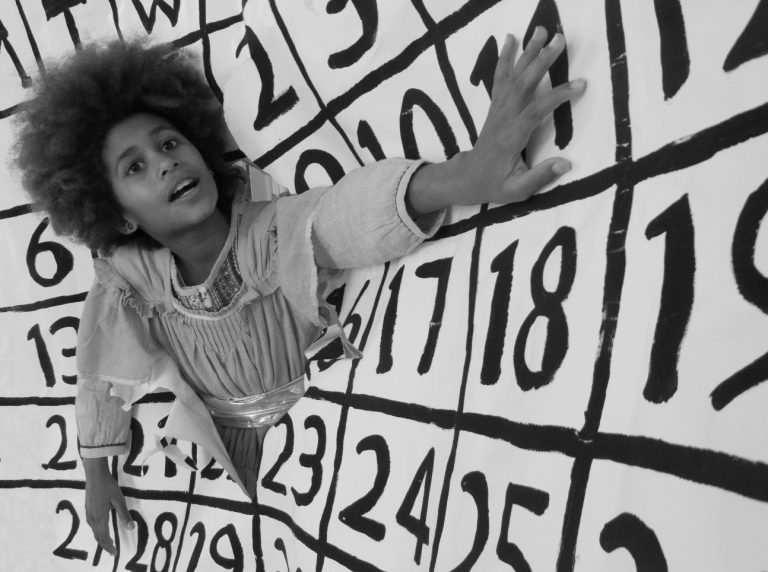
‘At Play’ by CAMHS Campus School Springfield Hospital
I had been invited to develop an outreach project for young people at the CAMHS (Child and Adolescent Mental Health Services) Campus School at Springfield Psychiatric Hospital in Tooting. The aim was to inject a bit of haptic learning and playful open-ended creativity into their curriculum. Initially I didn’t anticipate including the outcome in an exhibition, but I saw the potential of using Christie Brown’s process and practice as the inspiration for a 3D figurative installation.
Working with 15 young people and staff from the CAMHS Campus School, over 6 weeks we co-created the installation ‘At Play’, a surreal sculptural fantasy of what some of the museum’s liberated inhabitants might get up to when everyone has gone home.
We had to overcome the fact that the young people involved were not able to visit the museum or see the exhibition in development. For a variety of practical reasons we were unable to work in clay, but we mirrored Christie Brown’s practice in other ways. We used collection objects we could handle as props in our story building, developing scenarios about how off-duty and liberated toys might behave at night, unobserved in the museum. We sculpted with paper, wire, wool and made casts of body parts and doll faces to create the evolving characters, much like her sculpting and press mould techniques.
The response by the young people and staff who took part in the project highlighted the impact this kind of open-ended, playful making can have in a hospital context. They unleashed their imaginations and created fantastically inventive figures and narratives.
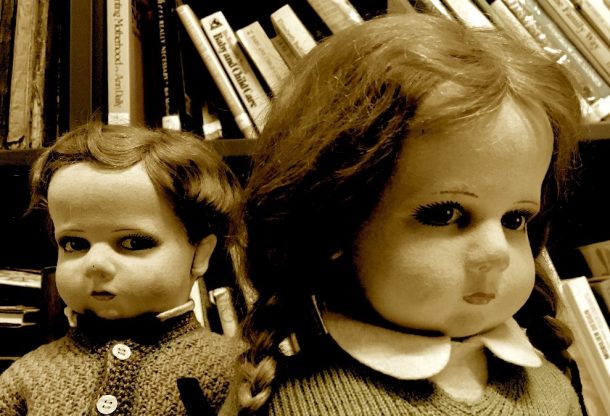
The Finished Product
Christie Brown researched the collection extensively from February 2017. She was particularly drawn to dolls, dolls houses and teddy bears. After weeks of developing the concept, photographing and sketching, she started prototyping in the summer to create four dream-like tableaux. ‘Ludus Est’ directly references dolls and toys in the collection as well as her own childhood memories. The two central ceramic figures in her scenes are based on a couple of anxious-looking felt dolls in the costume collection, made in the 1920s by the Italian Lenci company. The evolving fantasy narrative is that the two dolls, on display by day, go wandering by night, visiting other objects in the museum under the cover of darkness.
As Christie developed her ceramic tableaux, the Lauriston photography project began. It produced striking accounts and images of familiar and not-so-familiar dreams. As the project progressed, the children learnt how to translate their thoughts and dreams into theatrical visual compositions.
Our resulting exhibition combines the distinct elements produced in different contexts into a whole, where they speak to each other visually and conceptually. As the individual projects develop organically, and at their own pace, it is often quite difficult to imagine what the finished product might look like. Luckily, on this occasion all of the above projects came together to create an exhibition that is visually stunning and speaks to a multitude of audiences.
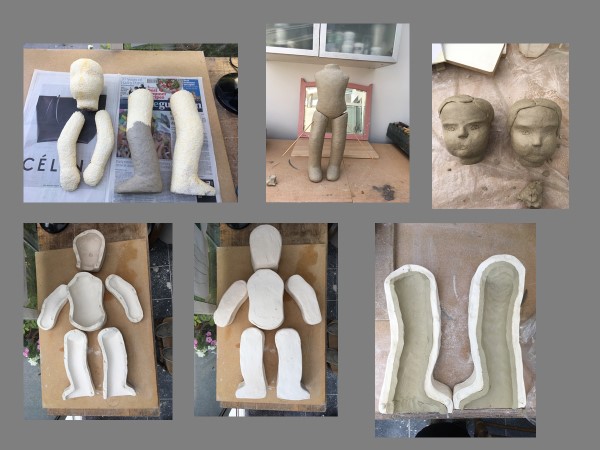
To end this post I will look to a quote from Piers Torday, who opened the exhibition. He sums up the project neatly:
There is some very powerful work here, and not just from Christie, but from the young people of CAHMS Campus school, Springfield Hospital, for whom, in certain cases, their own liberty remains something of a dream.
But what we also see in this show of work, from adult to teenagers to younger children, some creating professionally, creating as part-therapy or simply creating as play, that self-expression is the great liberator. It’s particularly heartening to see a museum engaging with and supporting art in local schools, when we know that arts subjects are hugely under pressure in the curriculum. The creativity shown in response to this brief has made some wonderful art, but it could also one day solve a design challenge, power a new invention, and solve multiple problems, as well as add to the diversity and richness of our culture.
What I take away from this multi-layered collaboration of different artists, experiences and media is that there are few things more life enhancing and alluring than being given the freedom to dream. So, dream on!


